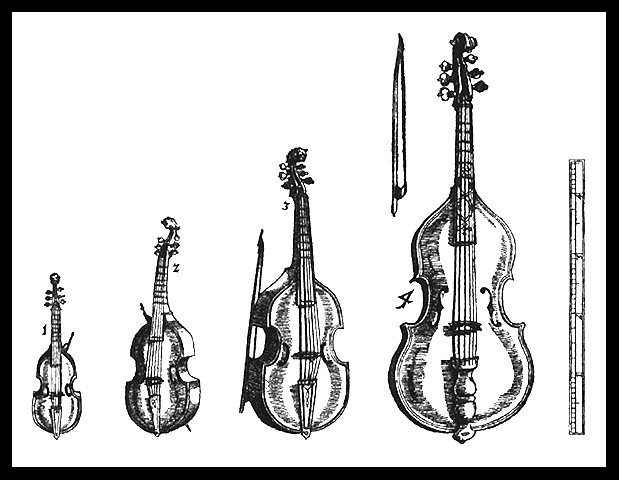A miscellany like Grandma’s attic in Taunton, MA or Mission Street's Thrift Town in San Francisco or a Council, ID yard sale in cloudy mid April or a celestial roadmap no one folded—you take your pick.
Sunday, November 11, 2012
Allegro from Sonata in A Minor BWV 1039 (or BMW 1027)
Happy Sunday, friends. I’m back with some music for your listening pleasure today, & also a short post, which you may enjoy perusing as you listen.
Yes, I do indeed have a fascination with the viola da gamba, & it dates back at least several years, probably to about the time when I was most fascinated by the harp guitar. At that time, the Lark in the Morning stores were still open, & we were on the mailing list for their catalog—& yes, they did indeed sell violas da gamba! Pricey items (like harp guitars) even at the low end of the range.
The viola da gamba is properly speaking a “viol,” & while it looks very much like a 7-string cello with frets (!), it is as much a cousin to the modern guitar as it is to the cello. Both the viola da gamba & the guitar descended from a common ancestor called the vihuela. The vihuela was played either with the fingers, a plectrum or after a certain point, with a bow—the vihuela de arco. Like the modern guitar, the vihuela was tuned in fourths with one interval of a third, & in fact, the viola da gamba also shares this quirky tuning. In addition, the viol, the vihuela & the guitar (prior to the advent of the modern steel string version) all had flat fingerboards, whereas the violin family all have fingerboards with a curve that’s visible to the naked eye. Steel string guitars also have a radiused fingerboard, though the curvature really isn’t that noticeable (unless you play slide); in the case of steel string guitars, the slight radius tends to facilitate playing barre chords—barring is done on a classical guitar too, of course, but not really as a way of playing closed position chords.
The “gamba” in viola da gamba simply refers to the fact that the instrument is held in place by pressure from the knees. Viola da gambas don’t have the end pin you find on modern cellos that rests on the floor—in fact, the baroque cello also didn’t have such an end pin. It’s also worth noting that viols came in different sizes—while we mostly see the tenor size nowadays, viol consorts consisted of treble, alto, tenor & bass.
In today’s, Lucile Boulanger is the violist here, & she & harpischordist Arnaud de Pasquale produce a fine duet here. For those who are interested in the catalog number (the BWV, which is how Bach’s music is catalogued), the video itself titles this BWV 1039, while the IMSLP site calls it BWV 1027. IMSLP states about BWV 1039: “Possibly an arrangement of a trio sonata for different instruments (e.g., 2 violins and basso continuo.) Later arranged for viola da gamba and harpsichord as BWV 1027.”
However it’s catalogued, this is sublime music —enjoy!
Image Links to its source on Wiki Commons
"Various Viole da gamba/Viols" - public domain [the tenor viol is second from the right]
Subscribe to:
Post Comments (Atom)

Ah, it's always great to start a Sunday morning with Bach! I got spoiled living in New England; starting in the mid '70's WGBH radio host Robert J. Lurtsema played one of Bach's sacred cantatas every Sunday morning at 8. Robert J. played them in their BWV number order, but after his passing, when Brian MacCreath took over Morning Pro Musica, they were played in a different order - according to which Sunday in the Lutheran liturgical year they were written for. I still listen to WGBH, but now on the computer as I'm not in broadcast range any more. And the sacred cantatas aren't on at 8 of a Sunday morning any more. But Brian continues the sacred cantata tradition with his all Bach show on Sunday evenings.
ReplyDeleteHi Roy: Thanks, so glad you liked it! & I enjoyed your Cantata post on Facebook & will look forward to others. The great thing is you can get WGBH over the 'net!
DeleteI used to play treble viol a lot years ago, when I was a student. Since I was in a music dept there was no trouble getting a consort together. We played a lot of early music - Gibbons' Fantasias, Dowland's Lachrimae Pavans, Jenkins... I think playing the viol in these pieces was probably the most thrilling musical experience I've ever had. Sadly, I don't own a viol these days, although I do still have a rebec. (It sounds like a violin played down a telephone).
ReplyDeleteHi Dominic: I love that description of the rebec's sound! Am a bit familiar with them through early music recordings. Playing in the viol consorts sure sounds like a lot of fun!
Delete